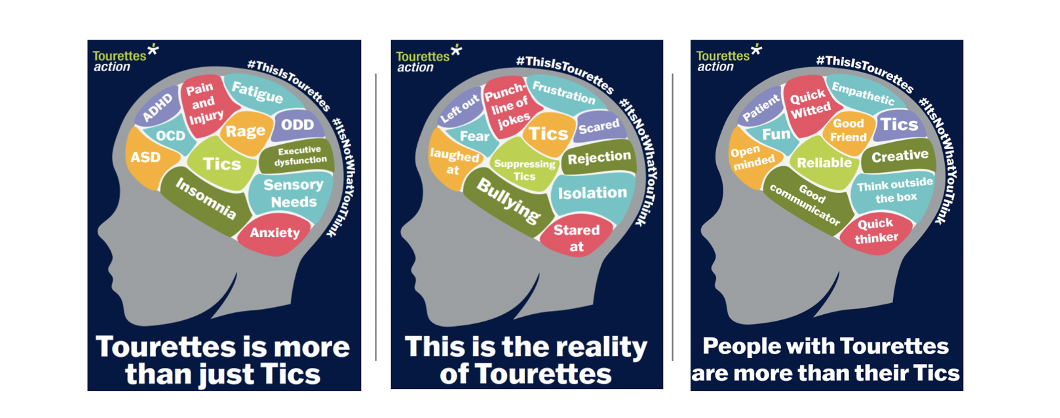An overview of Tourette’s Syndrome
06/06/2022

If I write the word ‘Tourettes’, the first thing you will likely think about is swearing. That’s not unusual because in the popular media it’s normally the first thing that’s mentioned when someone comments on the condition. But, coprolalia (from the Greek ‘kopros’ meaning dung, and lalia meaning speech) affects only 15% of those with Tourette’s Syndrome (TS).
June 7 is Tourette Syndrome Awareness Day so it feels appropriate to share some knowledge about it. TS is a childhood-onset neurological disorder characterized by involuntary physical movements known as motor tics; and at least one phonic tic (noises and words). Many of those with TS will also have a co-condition such as Attention Deficit Hyperactivity Disorder (ADHD), Obsessive Compulsive Disorder (OCD), and Anxiety.
TS typically manifests before puberty and is more common in boys than girls. In population-based and clinical sample studies tic severity typically peaks between 8 and 12 years of age. For many the onset of adulthood coincides with a noticeable reduction in severity. However, many individuals who have TS in childhood continue to have tics into adulthood.
The condition is named after Dr Georges Gilles de la Tourette (1857-1904) who first identified the medical phenomenon in 1884. He described the condition that he observed in nine patients who were exhibiting involuntary tics. At that time the condition was thought to be psychiatric but the work of Arthur and Elaine Shapiro in the 1970s challenged this and, through extensive work, promoted the view of it being neurological in origin.
The neurobiological causes of tics are, like much in the field of neurodiversity, under regular review and research. However, studies and brain imaging indicate the involvement of the brain circuit that controls movement execution, habit formation and reward (the ‘cortical– striatal–thalamocortical’ (CSTC) pathways. Other research has indicated that it may have an inherited component – with parents and children sharing TS-type behaviour.
There is a paucity of studies into adults with TS, especially those in work and this is an element of continued research by Cranfield University into neurodiversity. However, what is known is that many adults with TS do feel that it interferes with their life. Robertson et al. (1993) notes that, in comparison to the general population, adults with TS have higher social anxiety, depression, and obsessionality. The TS population also has higher levels of unemployment and problems in dating and in making and keeping friends, in addition to facing social and occupational discrimination.
TS can also have several physical consequences such as musculoskeletal or neuropathic pain, tissue damage resulting from tic repetition (e.g., stress fractures), or injury caused by striking an object when performing a tic (Fusco, et al. 2006). Sometimes tics can manifest in severe, continuous, non-suppressible, physically, and mentally demanding events called ‘tic attacks’ (also called ‘tic fits’) that can leave people exhausted.
It is initially strange to be with someone who is making noises or ticking. But that is because many of us may not have come across it in our working lives. That in itself is a powerful point. We should. The societal model of neurodiversity is one that pronounces that it is society that places barriers in the way of people with a difference.
Those with TS, like all neurodivergents, have so much to give to society and to companies that employ them. The charity Tourette’s Action has produced a series of powerful posters that frame this so well. The reality of Tourette’s is the tics and comorbidity, it is the way society regards people as being the punchline in jokes or being left out – but, it is also the innovative, quick thinking, empathetic, reliable element of the person that is just as important.
As our research into neurodiversity continues it is worth continuing to emphasise that the need for understanding and education is paramount.
Tourette’s Action can be contacted via:
https://www.tourettes-action.org.uk/
You can also take a look at this video from Tourettes Action that looks to dispel the myths around TS.
References:
Champion, L. M., Fulton, W. A., & Shady, G. A. (1988). Tourette syndrome and social functioning in a Canadian population. Neuroscience and Biobehavioral Reviews, 12, 255–257.
Fusco, C., Bertani, G., Caricati, G., & Della Giustina, E. (2006). Stress fracture of the peroneal bone secondary to a complex tic. Brain and Development, 28, 52–54.
Leckman, J.F. (2002). Tourette’s syndrome. Lancet. 360: 1577–1586.
Leckman, J.F. (2012). Tic disorders. British Medical Journal, 344: d7659
Robertson, M. M., Channon, S., Baker, J., & Flynn, D. (1993). The psychopathology of Gilles de la Tourette’s syndrome: A controlled study. British Journal of Psychiatry, 162, 114–117.
Categories & Tags:
Leave a comment on this post:
You might also like…
Study better and smarter in 2026
Happy new year! Now is the perfect time to reflect on your studies so far, thinking about what you’re doing well and where you need to focus a bit more attention. Getting back into ‘study ...
Cleared for the future: Why aviation leaders must embrace environmental sustainability
Environmental sustainability is not a niche concern for aviation anymore, it’s central to how we think about the future of our industry. In my work as an Associate Professor of Airport Decarbonisation, I see first-hand ...
Preparing your work for Turnitin submission
Before submitting your work into Turnitin for similarity checking, if you have used referencing software then you may need to take some important steps first. Mendeley and Zotero integrate with MS Word by embedding field ...
The fast track to supercar engineering: My Cranfield journey
It’s been a dream come true to work on some of the world’s most prestigious supercars – the Aston Martin Valhalla, McLaren 750 & Artura, the GMA T.33. But every successful ...
Automotive Engineering: From student to hypercar innovation at Rimac
We sat down with recent graduate Thomas Perrin, to discuss how his year on the MSc in Automotive Engineering at Cranfield University propelled him from the lecture hall directly into the ...
What this year at Cranfield really meant to me
Every Cranfield journey is unique. In this alumni reflection, Zachea Scicluna shares what her year at Cranfield truly meant, from facing uncertainty to gaining hands-on experience in industry-backed projects. I’ve been reflecting (and delaying) ...






